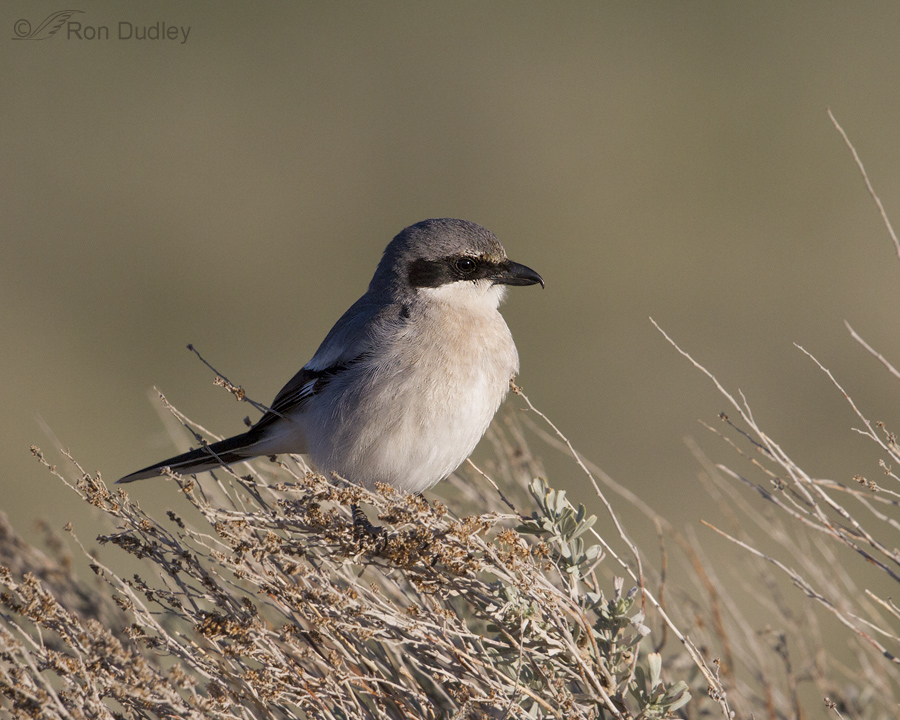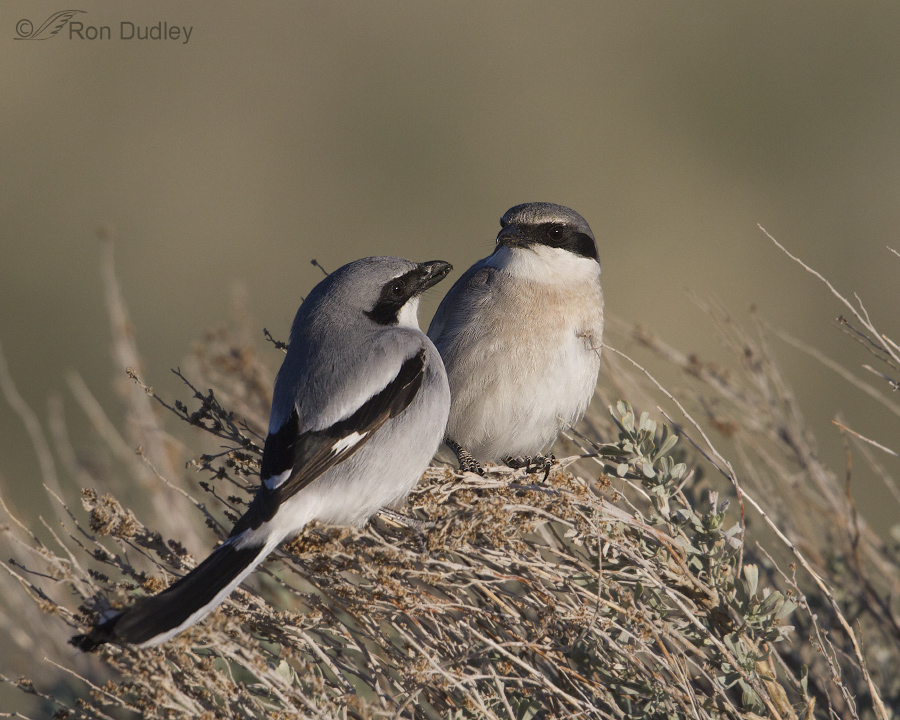I have very few images of mated pairs of songbirds that I like. This second shot from yesterday is one of them.

1/4000, f/6.3, ISO 640, Canon 7D, Canon EF500mm f/4L IS II USM, 1.4 tc, not baited, set up or called in
I photographed this Loggerhead Shrike yesterday morning on Antelope Island. With the strong sidelight I didn’t have a lot of enthusiasm for images of the bird while it was perched so I was set up for take-off shots (fast shutter speed, high ISO). For me the strongest asset of this image is the good look at the strongly hooked bill of this wanna-be raptor.
But then something totally unexpected and fortuitous occurred.

1/5000, f/6.3, ISO 640, Canon 7D, Canon EF500mm f/4L IS II USM, 1.4 tc, not baited, set up or called in
Another shrike flew in and landed right next to the bird I was photographing! I fired off a few quick shots and then adjusted my aperture for more depth of field but by then the bird on the left had turned its head to the left so those shots have no eye contact. Of the first images I took only this one had good sharpness on both birds.
Based on their behavior this time of year I’m almost positive they were a mated pair and I suspect the bird on the left to be the male. I like the contrasting poses, the way both birds are looking at each other, the natural perch and the catch lights in both visible eyes. And I think the sidelight worked pretty well, particularly on the bird on the left.
Once again, serendipity saved the day.
Ron


OK! So they havE a soft side!!!
Serendipity is such a wonderful, wonderful thing.
Wanna-be raptors? I suspect that they would challenge that assessment, and so would their victims.
And Patty and I have first dibs on diving through your ‘not quite up to the mark’ archives.
It looks to me as well as if the bird on the left might be bringing “courtship” food? Lovely image…
Thank you, Deborah.
Another beautiful image, Ron! It’s amazing that you were able to capture both birds together, a seldom photographed and seen occurrence.
It’s “seldom photographed” by this photographer anyway, Gail. I was glad to get them together.
Lovely!
Thanks, Tana.
Serendipity strikes again! I think the sidelight really works here. Otherwise, you may not have been able to get the catchlight in both birds’ eyes. Also, I like the way it highlights the nuances in their plumage.
I found my first ever Loggerhead Shrike nest last week. The male was bringing the female food as she brooded eggs.
Speaking of food, it may be my imagination, but was there a transfer of food going on here? I can make myself believe I see something like ants in the beak?
Very nice work with the Butcher Birds, Ron!
Wally, I watched for a food exchange when this went down but if it occurred I missed it. Couldn’t see it in any of my other images either. Thank you.
Gotta love that serendipity! Interesting how it follows some photographers around more than others.
Yes! to “I like the contrasting poses, the way both birds are looking at each other, the natural perch and the catch lights in both visible eyes. And I think the sidelight worked pretty well, particularly on the bird on the left.”
Thank you, Dave. I’m not sure I get more serendipity than anyone else. In fact at times I think it has abandoned me forever and then poof, it happens again…
oh wow, Ron, that second shot with the birdies looking right at each other is SO beautiful!!!!!!
Thanks very much, Lois.
Great, that really gives a nice perspective of the area and the juvie, many thanks.
Oh my, you should have Mia take a shot of them landing on your truck while you are trying to get a picture of them. That image would be fantastic!!
Dick, This post includes a shot of one of the juvies on my pickup – next best thing to the potential image you describe.
https://www.featheredphotography.com/blog/2013/07/12/fledgling-loggerhead-shrike-begging-for-food/
Excellent as usual, Ron
This will be an interesting piece for me, if you stay with them while they are nesting, since my knowledge is quite deficient with this species.
I’m going to try to “stay with them”, Dick – we’ll see how it turns out. Last year I followed a pair and their offspring for several weeks and had a blast with them. They got so used to me that the juvies and adults were even landing on my pickup.